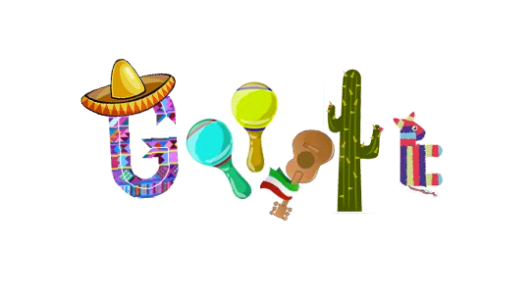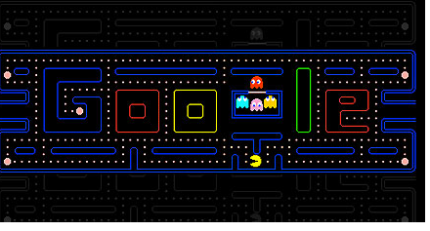View my Google Doodle:
Interactive digital art is a form of art that involves the observer to take part in the experience of the work. In return, this allows the artwork to achieve its purpose. Interactive digital art installations can accomplish this by allowing the viewer to experience the work through physical touch, sight, sound, and sometimes manipulation of the piece. Digital interactive works often feature technological aspects such as computer monitors, sensory devices, and programs that are designed to respond to and change in accordance with heat, time, motion, and similar factors. [1] An example of this type of interactive digital media, and arguably one of the largest PR coups in the world, is The Google Doodle.
Google, which is the most commonly used web search engine in the world, displays two things on its homepage: the Google logo and a search engine bar. “Google Doodles” are illustrations substituting the Google logo that feature still-standing illustration, motion graphics, and sometimes-interactive pieces in prime placement on the single most popular landing page on Earth. This allows artists from all over the world an opportunity to have their work featured and interacted with by an average audience of about two million people. The doodles always feature the primary logo for Google, but can be manipulated in a variety of ways. Most Google Doodle designs coincide with holidays, historical events, or iconic figures.[2] The point of the Google Doodle is to provide a user-friendly experience with the Google search engine as well as spark the discovery of innovation, creativity, and inventiveness from all that come in contact with the animation.
Founders Larry Page and Sergey Brin designed the first doodle in 1998 while they were attending the Burning Man Festival in the Nevada desert. They replaced the “o” in the logo with a stick figure drawing to let users know they were “out of the office”. Users of the search engine were both surprised and delighted to see a change to the standard and simple Google logo. They enjoyed the experience and the playful nature of, what was then, a very young company. [3] Since that discovery, there have been over a thousand doodles debuted on the Google homepage around the world. Some images run globally and others are specific to one country. The doodles started off as simple illustrations and progressed into more complex pieces. As technology has developed over time, so have the Google Doodles. In 2011, users were given the opportunity to explore “20,000 Leagues Under the Sea” with Jules Verne. This interactive illustration allowed visitors to navigate underwater scenes directly out of “20,000 Leagues under the Sea”. When visting the Google home page on that day, the letters in the Google logo were shaped like portholes on a submarine with a lever on the right side of the page that permitted users to shift up, down, left, and right for a glimpse of the deep seas.[7] This example of interactive digital media set the bar for the many interactive Google experiences to come.
Who designs the Google Doodles? After the first doodle was created, freelance artist and web master Dennis Hwang became the Chief doodler and commissioned a group of illustrators and engineers. The team works with guest artists and creates competitions allowing people from all over the world to submit illustrations with the chance of being featured.[3] January 2011 was the launch date of the Doodle 4 Google contest: A competition where kids from the United States, grades K-12, were able to enter their Doodle designs for a chance to have it debuted for the day. Such competitions are held year-round and produce a large amount of competitors.
Google Doodles allow the audience to engage with the illustrations and provide interactions such as scrolling over the letters to change the positioning of them or participating in actual game play. An example of this would be the Pac-man Google Doodle, featured in May 2010 (Pac-Man’s 30th birthday celebration). This acted as the first playable Google Doodle. The illustration was programmed so that viewers could participate in an actual game of Pac-Man, whose game course was wrapped around the Google letters. During this experience, users had the opportunity to gain points, die, and even play against one another.[4] This sense of involvement is very similar to the article by Sherry Turkle: Video Games and Computer Holding Power. In the article, Turkle explains that “Video games are a window into a new kind of intimacy with machines that is characteristic of the nascent computer culture.” [5] The sense of belonging and involvement that comes with participating and engaging in a video game holds an immediate connection to the idea behind what the doodle web graphics are trying to create. Having the sense of power and control over the turnout of the piece of work gives the audience a feeling of importance, and in some cases a sense that the artwork is dependent upon the viewer.
After researching the Google Doodle, my curiosity was sparked and I decided to create a Google graphic of my own. The process started in late September during the brainstorming stage. After I chose to do my research assignment based on interactive web art with a concentration in Google web images, I decided that I wanted to create something that correlated with a particular holiday. One of my favorite holidays is Cinco de Mayo, which is a holiday that I felt would lend me the opportunity to design a graphic based on rich culture. After my holiday was chosen, I did a great deal of research on what the holiday stands for, when the holiday occurs, and possible elements that I should include in my graphic. Next, I decided that I wanted to create something that the audience would deem as interactive. The final result was a festive Google Doodle encompassing the main traditions of Cinco de Mayo and the Hispanic culture as a whole. Hypothetically speaking, as you scroll along the letters, each movement takes you through a different animation. The “G” has a sombrero that moves up and down, the “o”’s are shaped as maracas that shake when scrolled across, the second “g” is shaped like a guitar that has the Mexican flag draped across the bottom, which waves back and forth, the “L” is shaped as a cactus that, when scrolled over, creates blooming Dahlias, which are the flowers of Mexico, and the “E” is shaped as a piñata that bounces up and down.
My objectives in creating this graphic was to provide an interactive, light-hearted experience in a way that came across as a clear representation of the Cinco de Mayo holiday. I think that I was successful in executing what I sought out to do. The project was done in a program called Adobe Flash, which is a program designed to allow you to animate objects, text, and video. Most motion graphics seen on the web are designed using this program. I first had to draw the illustrations and scan those into the computer to sharpen them, which took about two weeks. Next, I then transferred each of those illustrations into Flash and worked on bringing them to life, which took about a month. I received no outside help, as I was familiar with the program before starting this project.
This type of digital media and interactive art is extremely new age and differs quite a bit from digital art done in the past due to the constant growth of technology. As we are subjected to new material, medium, and ways of delivering that material, the art that is created also changes. Because Digital Art uses technology that is constantly changing, the work that is produced from that changes and grows at a parallel rate. Advances in technology have allowed our culture to do many things that we were once not able to do, such as connecting with other parts of the world with a click of a button. It has allowed us immediate access to a database of information, which is very important and completely reflective upon the type of art that is being created today. Incorporating a digital aspect in art lends it the opportunity to come alive in some instances. In the past, art has been thought of as something to “look at”. As we move further into advances with technology and resources, it is becoming more and more about something to “participate in”. It is now giving someone, who once had the role of “viewer”, the role of “participator”. I think a lot of this has to do with the ways that technology is changing the way we learn, interact, and view the world. Having a chance to interact and participate with artwork gives the viewer a better understanding of the piece.
This project gave me the opportunity to see Digital art in a whole new light. I was able to gain firsthand experience on how interacting with digital art leaves the viewer with a certain emotional draw to the piece. For my project, I was able to witness several people looking at my animation and got different emotional responses from each person. While each response was different, the purpose of leaving an impact on the viewer remained as the constant. If I were to improve this project, I may create an even more interactive experience with a Google graphic which allows different outcomes based on which moves the viewer chooses to take. Overall, this project has strengthened my understanding of interactive digital art and it has encouraged me to continue my investigation.
Bibliography:
[1] “Interactive Art.” Wikipedia. Wikimedia Foundation, 13 Nov. 2012. Web. 27 Nov. 2012.
<http://en.wikipedia.org/wiki/Interactive_art>.
[2] Rubel, Steve. “How Much Traffic Does a Google Doodle Drive? The Data Says, A Ton | Edelman Digital.” Edelman Digital. N.p., 9 May 2011. Web. 27 Nov. 2012.
[3] “History – Doodle 4 Google.” History. N.p., n.d. Web. 27 Nov. 2012. <http://www.google.com/doodle4google/doodler.html>.
[4] “30th Anniversary of PAC-MAN.” 30th Anniversary of PAC-MAN. N.p., n.d. Web. 27 Nov. 2012. <https://www.google.com/doodles/30th-anniversary-of-pac-man>.
[5] Sherry Turkle: : “Video Games and Computer Holding Power”


